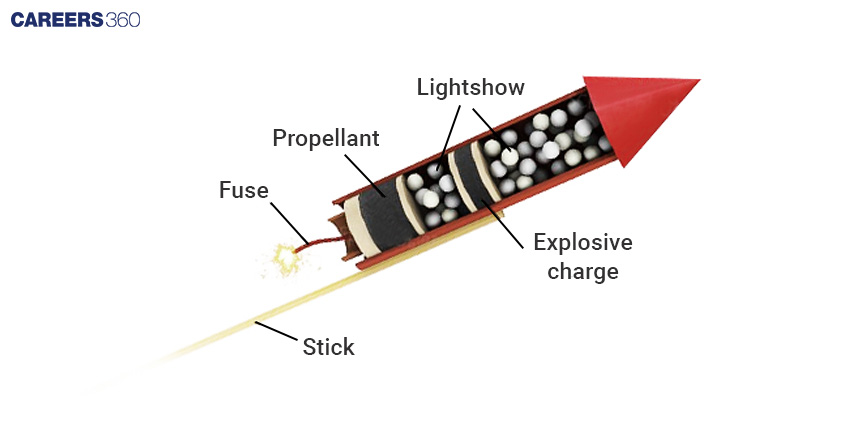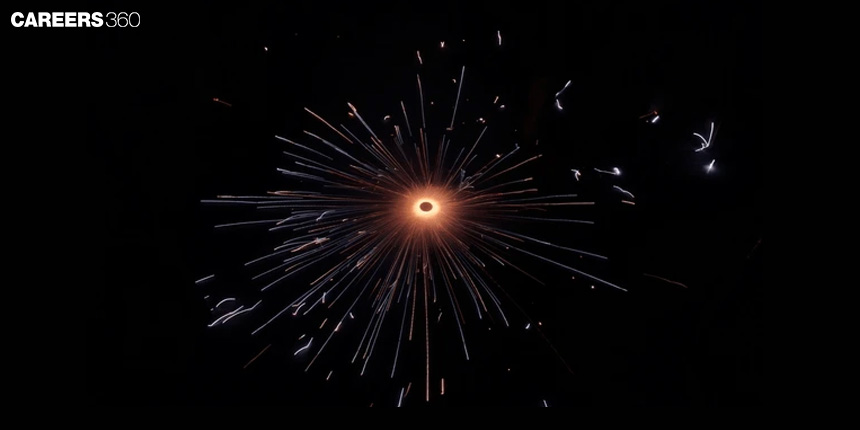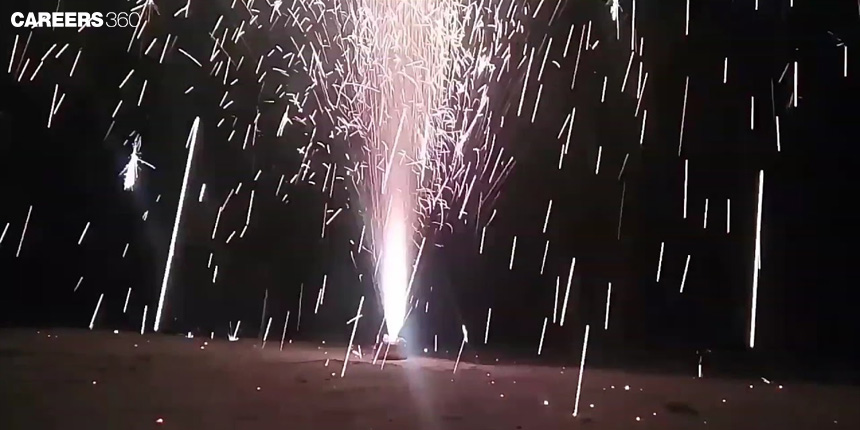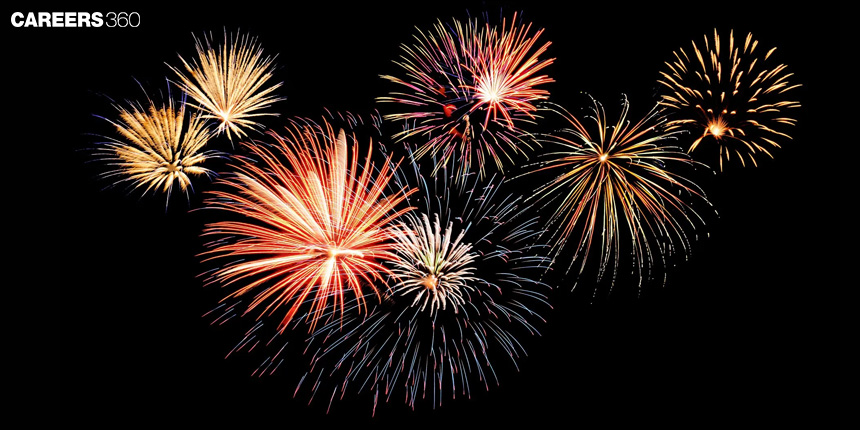What Is The Physics Behind Different Firecrackers?
Fireworks make celebrations extra special, turning the night sky into a magical display of colors and sounds. But have you ever wondered how they work? It's not just magic; there's a whole bunch of science behind those bursts of joy!
This Story also Contains
- Rocket Fireworks
- Chakri (Spinning Fireworks)
- Anar (Fountain)
- Ground Spinner

In this article, we're going to explore the cool science that makes different fireworks, like rockets - the ones that shoot up in the sky, chakris - the ones that spin around, or anars - sparkling fountains. So, buckle up, and let's kindle our understanding of firecracker science!
Also Read- Understanding How Volume, Pressure, and Temperature Team Up
Rocket Fireworks

When you light a firework, you start a chain reaction of cool physics. There's a mix of special stuff inside that small firework. When lit, this mixture burns quickly, producing extremely hot gases. Hot gases require space, and because the firecracker is small, they create a lot of pressure inside.
This is where Sir Isaac Newton's idea comes into play. He stated that there is an equal and opposite reaction to every action. When the hot gases shoot out one direction, the firecracker is pushed in the opposite direction. That's similar to when you shoot a water gun: the water goes out and the gun returns.
Following the kick, the firecracker takes a curved path into the air. This is due to gravity, the invisible force that pulls objects to the ground. The firecracker ascends, slows, and then descends in a graceful curve.
Chakri (Spinning Fireworks)

Chakris, those enthralling spinning swirls of fire, twirl around thanks to the power of centripetal force. Consider swinging a ball attached to a string in a circle. The centripetal force is the force that pulls the ball towards the centre of the circle and is what keeps the ball going in circles.
Consider a chakri to be a swinging ball. When you light it up, it begins to spin. The design of the fireworks is critical here. The flames and sparks shoot out as it spins, creating a spectacular display. But what causes it to spin in the first place? The centripetal force is at work, drawing the Chakri to its centre and keeping it in its circular dance.
In Chakris, the dynamics of circular motion involve two key concepts: speed and radius. The Chakri's behaviour is determined by the speed at which it spins and the distance between its centre and the outer edges (radius).
Consider twirling a rope with a weight at one end. You'll feel a stronger pull towards the centre if you spin it faster. Similarly, the faster a Chakri spins, the stronger the centripetal force pulling it inward.
The radius now enters the picture. You will feel less pull if you extend the rope. If the spinning firework in a Chakri has a larger radius, the centripetal force is less, affecting how it spins. Engineers carefully design Chakris to balance these factors, resulting in that perfect, hypnotic spin we enjoy during celebrations.
Anar (Fountain)

Anars, or fountains, add a magical touch to celebrations. An Anar's dance of burning particles is like a graceful performance orchestrated by gravity. When you light an Anar, it emits glistening flames as gravity comes into play these flames descend and voila you have the magnificent view of a crackling fountain.
Let’s understand this better. Consider throwing a ball into the air. What goes up must eventually come down, right? Gravity is at work, pulling objects towards the Earth. Similarly, as the Anar's burning particles rise and twirl, gravity quietly works to bring them back down. This descent is responsible for the mesmerising cascade of sparks that paints a fiery picture against the night sky.
Anars are miniature pyrotechnic fountains that work their magic through carefully orchestrated particle ejection. There are substances within the Anar that, when ignited, produce hot gases. These gases build up pressure and push against the materials around them.
When the pressure becomes too much to bear, the Anar expels burning particles to release the stored energy. Consider it a gentle burst of creativity. These expelled particles then twirl and dance, propelled by the force of the escaping gases, resulting in a fountain-like display.
Consider a mystical waterfall of light and colour, with each particle taking a brief, glowing journey before gracefully descending. It takes a symphony of physics and chemistry to transform a simple Anar into a radiant fountain of joy.
Ground Spinner

Coloured fireworks have vibrant colours due to the unique emission spectra of elements. Electrons in certain elements absorb energy and jump to higher energy levels when heated. As these excited electrons return to their original energy levels, they emit light energy, resulting in distinct colours. Each element emits light at different wavelengths, which contributes to the vibrant display.
Various chemicals contribute to the various colours seen in fireworks. Strontium compounds, for example, produce red hues, copper compounds produce blue or green hues, and sodium compounds produce yellow. Pyrotechnic experts can create a captivating palette of colours in the night sky by carefully selecting a combination of these chemicals. The art of selecting and blending these chemical contributors is an art in and of itself, resulting in a visually stunning and harmonious fireworks display.
Understanding the hues in fireworks requires an understanding of the relationship between electron transitions and colour. Photons are emitted when electrons move from higher to lower energy levels. These photons' energy corresponds to specific colours in the visible spectrum. Reds and oranges are produced by longer wavelengths, while blues and violets are produced by shorter wavelengths. By selecting elements with precise emission spectra, pyrotechnicians can create a dazzling array of colours.
After unravelling the science behind the fireworks, the night sky transforms into a magical stage where each burst reveals a fascinating tale of chemistry and physics, making the celebration even more enchanting.
Also Read- Handy Tips For Solving Time And Work Aptitude Problems
Applications for Admissions are open.
As per latest syllabus. Physics formulas, equations, & laws of class 11 & 12th chapters
JEE Main Important Chemistry formulas
Get nowAs per latest syllabus. Chemistry formulas, equations, & laws of class 11 & 12th chapters
JEE Main high scoring chapters and topics
Get nowAs per latest 2024 syllabus. Study 40% syllabus and score upto 100% marks in JEE
JEE Main Important Mathematics Formulas
Get nowAs per latest syllabus. Maths formulas, equations, & theorems of class 11 & 12th chapters
